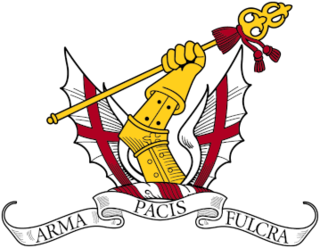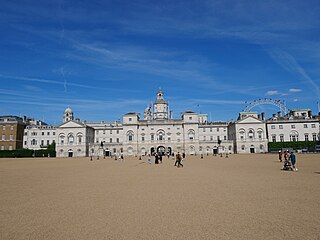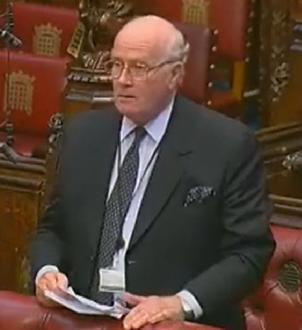Related Research Articles
Warrant officer (WO) is a rank or category of ranks in the armed forces of many countries. Depending on the country, service, or historical context, warrant officers are sometimes classified as the most junior of the commissioned officer ranks, the most senior of the non-commissioned officer (NCO) ranks, or in a separate category of their own. Warrant officer ranks are especially prominent in the militaries of Commonwealth nations and the United States.

The Royal Regiment of Artillery, commonly referred to as the Royal Artillery (RA) and colloquially known as "The Gunners", is one of two regiments that make up the artillery arm of the British Army. The Royal Regiment of Artillery comprises thirteen Regular Army regiments, the King's Troop Royal Horse Artillery and five Army Reserve regiments.
Regimental sergeant major (RSM) is an appointment that may be held by a warrant officer (WO) in the British Army, the Royal Marines, and the armies of many other Commonwealth and former Commonwealth nations. It is also an actual rank in the Irish Defence Forces, and formerly in the British Army, Royal Marines and United States Army. Only one warrant officer holds the appointment of RSM in any regiment or battalion, making them the senior warrant officer; in a unit with more than one top-ranked WO, the RSM is considered to be first amongst equals". The RSM is primarily responsible for assisting their commander in maintaining standards and discipline amongst the non-commissioned members and acts as a parental figure to their subordinates, sometimes referred to by the mantra "Drill, Dress and Discipline".

The Honourable Artillery Company (HAC) is a reserve regiment in the British Army. Incorporated by royal charter in 1537 by King Henry VIII, it is the oldest regiment in the British Army and is considered the second-oldest military unit in the world. Today, it is also a charity whose purpose is to attend to the "better defence of the realm", primarily through supporting the HAC regiment. The word "artillery" in "Honourable Artillery Company" does not have the current meaning that is generally associated with it, but dates from a time when in the English language that word meant any projectile, for example arrows shot from a bow. The equivalent form of words in modern English would be either "Honourable Infantry Company" or "Honourable Military Company".
Sergeant major is a senior non-commissioned rank or appointment in many militaries around the world.

Horse Guards Parade is a large parade ground off Whitehall in central London. It is the site of the annual ceremonies of Trooping the Colour, which commemorates the monarch's official birthday, and the Beating Retreat.

Field Marshal Sir Geoffrey Harding Baker, was Chief of the General Staff, the professional head of the British Army, from 1968 to 1971. He served in the Second World War and became Director of Operations and Chief of Staff for the campaign against EOKA in Cyprus during the Cyprus Emergency and later in his career provided advice to the British Government on the deployment of troops to Northern Ireland at the start of the Troubles.

"Other ranks" is the term used to refer to all ranks below officers in the British Army and the Royal Marines. It includes warrant officers, non-commissioned officers ("NCOs") and ordinary soldiers with the rank of private or regimental equivalent. Officers may, in speaking, distinguish themselves from those "in the ranks".

Horse Guards is a historic building in the City of Westminster, London, between Whitehall and Horse Guards Parade. It was built in the mid-18th century, replacing an earlier building, as a barracks and stables for the Household Cavalry. The current and previous buildings were, between the early 18th century and 1858, the main military headquarters for the British Empire. Horse Guards originally formed the entrance to the Palace of Whitehall and later St James's Palace; for that reason it is still ceremonially defended by the King's Life Guard.

Field Marshal Richard Frederick Vincent, Baron Vincent of Coleshill, was a British Army officer. After serving with British Army of the Rhine he served with the Commonwealth Brigade in Malaysia during the Indonesia–Malaysia confrontation. He commanded the 12th Light Air Defence Regiment in Northern Ireland during the Troubles, for which he was appointed a Companion of the Distinguished Service Order, and later commanded the 19th Airportable Brigade. Although he never served as one of the individual service heads, he went on to be Vice-Chief of the Defence Staff in the late 1980s and then Chief of the Defence Staff in the aftermath of the Gulf War. He subsequently became Chair of the Military Committee of NATO in the mid-1990s.

General Sir Timothy John Granville-Chapman, is a former British Army officer, who served as Vice-Chief of the Defence Staff of the British Armed Forces (2005–2009).
Master gunner is an appointment of the warrant officer rank in the British and United States armed forces.
Quartermaster sergeant (QMS) is a class of rank or appointment in some armed forces, especially those of the United Kingdom and the Commonwealth, and formerly also in the United States.
General Sir Alexander George Hamilton Harley, is a retired British Army officer and former Adjutant-General to the Forces.
Lieutenant General Richard Arthur David Applegate CB OBE is a former Quartermaster-General and Master-General of the Ordnance to the Army. He left the British Army in October 2010.

A warrant officer (WO) in the British Armed Forces is a member of the highest-ranking group of non-commissioned ranks, holding the King's Warrant, which is signed by the Secretary of State for Defence.

The Royal Artillery Band was the first official, and permanent British military band originating in 1557, but granted official status in 1762. Consisting of woodwind, brass, and percussion instruments, it represented both the Royal Regiment of Artillery, and the state. The Royal Artillery Orchestra [disbanded on 9 February 2014] was Britain's first permanent professional orchestra. All other bands in the British Army received official, permanent status from 1763 onward. Now that the band's overall history of over four and a half centuries has come to an end, it is now claimed that the Band of the Grenadier Guards are the oldest band, with their overall history of over three hundred and thirty years. It is however, important to consider that until 1762, all military bands were formed as and when required, and then immediately disbanded when not, and that they consisted only of hired, civilian musicians; becoming integrated professional soldiers in 1762 and from 1763.
The King's Birthday Honours 1931 were appointments by King George V to various orders and honours to reward and highlight good works by members of the British Empire. The appointments were made to celebrate the official birthday of The King. They were published on 2 June 1931.
The 1940 Birthday Honours were appointments by King George VI to various orders and honours to reward and highlight good works by citizens of the British Empire. The appointments were made to celebrate the official birthday of The King, and were published on 9 July 1940.

The Corps of Royal Artillery Drivers was a British Army corps founded in 1793 and disbanded in 1822. It was established to provide trained and disciplined drivers for the Royal Artillery, a service that had previously relied upon civilian contractors. Though closely associated with the Royal Regiment of Artillery the corps was listed separately from it in the London Gazette until at least 1815. By 1814 the corps numbered more than 7,400 men and fielded more than 2,600 men at the 1815 Battle of Waterloo. The unit was reduced in size after the end of the Napoleonic Wars and disbanded in 1822 by the Duke of Wellington.
References
- ↑ "No. 58771". The London Gazette (Supplement). 22 July 2008. p. 11003.
- ↑ "No. 61916". The London Gazette (Supplement). 2 May 2017. p. 9030.